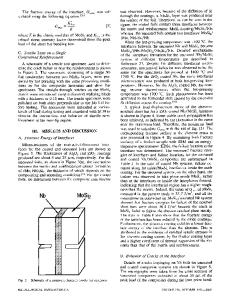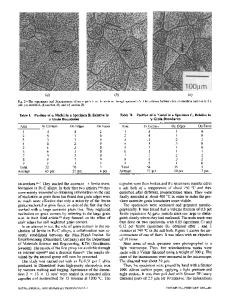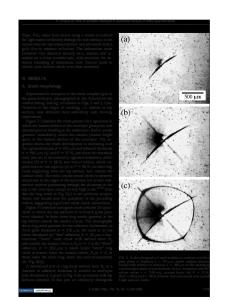The role of mobile dislocations in the nucleation of brittle fracture
- PDF / 3,028,563 Bytes
- 8 Pages / 597.28 x 785 pts Page_size
- 25 Downloads / 293 Views
I.
INTRODUCTION
IN an earlierstudy on Cr-Mo dual-phase steels, it was observed that the initial dislocation configurations in ferrite are related to the morphology o f second-phase islands, tL2~ When these islands were o f low-carbon martensite o r l o w e r bainite, the dislocations concentrated around the islands contained numerous shear-fragmented edge loops o f a/2(t 11) Burgers vector, while from the compact islands o f high-carbon martensite, elongated a/2(l 11) half loops were punched out, having a very short front edge portion that left behind long side trails o f screw dislocations. The long a/2(111) screw dislocations extending from asperities o f different martensite islands formed a characteristic crisscross configuration in ferrite grains. ]21 A similar crisscross configuration o f planar dislocation walls was found in a C-Mn-Si dualphase steel a f t e r 1 to 2 pet true plastic strain in tensionta~ and was considered relatively immobile due to the presence o f jogs on the a/2(111) screw dislocations and segments o f a(001) dislocations on intersections o f the screw ones. The a(001) segments are products o f the reaction t41 a / 2 ( l l l ) + a / 2 ( l l l ) = a(001)
[1]
which, as energetically favorable, may occur between families o f intersecting a/2(111) screw dislocations. The initial crisscross dislocation configuration was found to control, to a large extent, the development o f dislocation substructure during plastic strain. ]Sj During deformation at room temperature (RT) up to 10 pet o f plastic tensile strain, coplanar arrays o f dislocations dominated in ferrite, and the formation o f cell walls was incomplete. The coplanar arrays were in {110} slip planes and were composed o f intersecting a/2(l 1 I) screw dislocations, with a large amount on their intersections o f a(001) edge dislocation segments having their Burgers vector in the slip planes. This suggested possible m o bility o f the a(001) edge dislocations. S.T. MANDZIEJ, Consultant, is with Advanced Materials Analysis, Enschede, T h e Netherlands. This article is based on a presentation made in the symposium "QuasiBrittle Fracture" presented during the T M S fall meeting, Cincinnati, OH, October 21-24, 1991, under the auspices of the T M S Mechanical Metallurgy Committee and the A S M / M S D Flow and Fracture Committee. METALLURGICAL TRANSACTIONS A
The suggestion that the a(001) edge dislocations may be mobile was confirmed by in situ tensile tests in a transmission electron microscope (TEM).[6] In thin foils made o f 4 pet cold-rolled Fe510Nb-type high-strength low alloy (HSLA) steel having a developed cellular substructure and containing a substantial amount o f the a(001) dislocations, w h i c h mainly concentrated in the cell walls with some crossing the cells, movement o f the a(001) dislocations during straining was observed. The configuration o f the crisscrossing a/2(111) screw dislocations, being components o f the elongated dislocation half-loops, is characteristic o f ferrite deformed at l o w temperatures t7,8,9] and
Data Loading...











